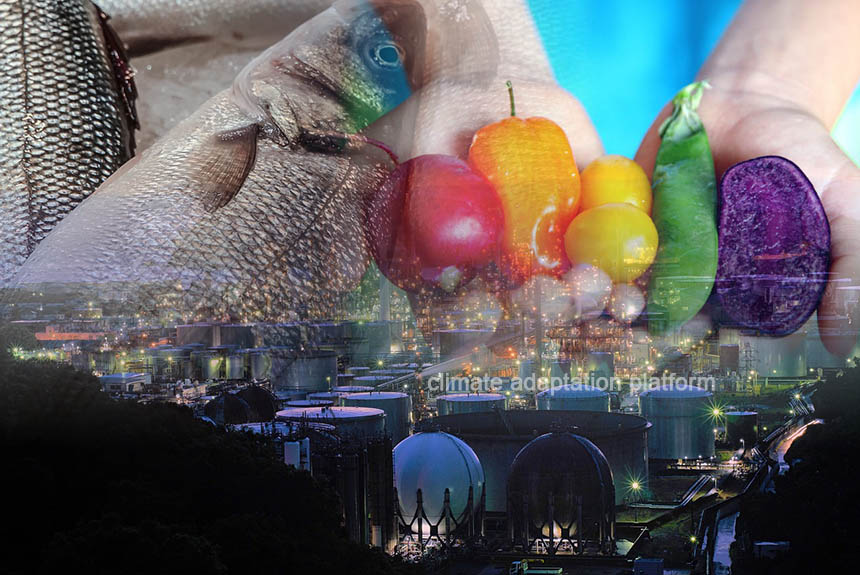Our diet affects the environment and contributes to climate change, and vice versa. Extreme events made worse and more frequent by climate change can impact crop yields and production. The industrialisation of food production, processing, transporting, and distribution to consumers emits enormous amounts of GHG. Around one-third of all anthropogenic GHG emissions are linked to food (Dogan, 2024).
Among the types of foods, animal-based food, like red meat, dairy, and farmed shrimp, has the highest GHG emissions. Per kilogram of food, beef has the highest amounts of emissions at 70.6, followed by lamb (39.7), Shellfish (26.9), Cheese (23.9), Fish (13.6), Pork (12.3), Poultry (9.9), Eggs (4.7), Rice and Grains (3.6), Milf (3.2), and Tofu (3.2), while at the end of the spectrum, Nuts (0.4), Vegetables (0.7), Fruits (0.9), Bread and Pastas (1.6), and Legumes (2) emits lower GHG emissions (Food and Climate, n.d.)
This is because meat production requires vast greenlands, obtained by clearing many trees, which then release the carbon they store. Sheep and cows emit methane, a potent planet-warming gas; their waste and fertiliser applied to grass also release nitrous oxide. Clearing mangrove forests to farm shrimp also releases stored carbon into the atmosphere.
A 2023 study, “Harnessing the connectivity of climate change, food systems and diets: Taking action to improve human and planetary health”, explored the connection of climate to food systems and diets and vice versa and the actions we can take to improve both.
It says that extreme events caused by climate change are negatively impacting food systems, affecting food production, storage, and transport, and they will jeopardise food availability and access, which can be detrimental to human life and health. At the same time, how food is grown, processed, packaged, and transported contributes to climate change and shapes food systems and deaths.
The paper highlights how food policies and actions can support dietary transition, contributing to climate adaptation and mitigation responses while improving human and environmental health. Governmental policies can guide towards healthier, more sustainable food choices.
For instance, marketing and advertising in the form of social media, print, TV, sports sponsorship, and product placements can be a tool to influence consumer behaviour. This places the responsibility on consumers to make the right choice when choosing their food and diets.
The United Nations also provides five tips on how to make your dietary choices can become climate actions. These include buying locally, growing your food, avoiding excess packaging when purchasing fruits and vegetables, eating less meat, and measuring what you eat. For example, cutting dairy and meat from our diets can result in a 66% reduction in carbon emissions (5 Ways Changing, 2021).
A WRI article, 4 Ways to Pursue a Sustainable Seafood Diet, suggests that including blue food in your diet to replace red meat can be a healthier option for both the body and the environment. Fish caught or cultivated in freshwater and marine environments is also a potential solution to address food insecurity and malnutrition and reduce greenhouse gas (GHG) emissions. There’s a caveat, though: blue food must be managed sustainably.
Unsustainable practices in the seafood industry create multiple problems, such as depleted fish populations, habitat damage and loss, pollution in fish farms, and significant waste. The article notes that 15% of fish and seafood are wasted in the food chain. To ensure that the fish you buy is sustainable, checking for sustainability certification and seafood rating systems on the labels can help.
Additionally, the article provides recommendations for achieving a sustainable approach to sourcing seafood. These include consuming fish species with a lower environmental impact. For example, opting for wild fish over farmed fish can significantly reduce carbon footprint.
Other tips include incorporating seaweed and bivalves such as mussels and clams into your diet, embracing seafood diversity by consuming a variety of seafood, using whole fish to minimise waste, and prioritising local purchases.
Our food system is a major contributor to climate change, and significant diet shifts can help achieve our targets under the Paris Agreement.
Reducing our consumption of beef, lamb and dairy – the highest GHG emitting food, substituting it with blue food and more plant-based food like vegetables, fruits, nuts, and grains- is good for our health and the planet, as studies have shown.
Sources:
Dogan, S. (2024, May 29). How are diet, food and climate change connected? Wellcome. Retrieved from https://wellcome.org/news/diet-food-and-climate-change
Food and Climate Change: Healthy diets for a healthier planet. (n.d.). United Nations. Retrieved from https://www.un.org/en/climatechange/science/climate-issues/food
Franzo, J. & Miachon, L. (2023, April 10). Harnessing the connectivity of climate change, food systems and diets: Taking action to improve human and planetary health. ScienceDirect. Retrieved from https://www.sciencedirect.com/science/article/pii/S2213305423000140?via%3Dihub
Frankfort, A. & Bottema, M. (2024, June 7). 4 Ways to Pursue a Sustainable Seafood Diet. World Resources Institute. Retrieved from https://www.wri.org/insights/blue-food-sustainable-seafood-die
5 Ways Changing Your Diet Can be a Climate Action. (2021, September 17). United Nations Climate Change. Retrieved from https://unfccc.int/news/5-ways-changing-your-diet-can-be-a-climate-action



Leave a Reply